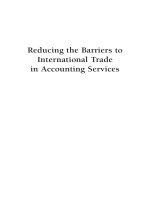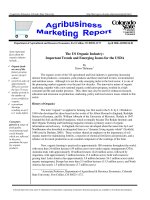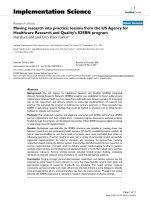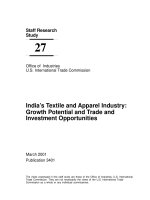international trade the us china trade war – causes and impacts
Bạn đang xem bản rút gọn của tài liệu. Xem và tải ngay bản đầy đủ của tài liệu tại đây (226.85 KB, 12 trang )
INTERNATIONAL TRADE
THE US – CHINA TRADE WAR:
CAUSES AND IMPACTS
Nguyễn Ngọc Như Nguyệt – FTC01
Student ID: 31181020788
Email:
download by :
ABSTRACT
The US-China trade war has been going on for more than 2 years but there is still no
sign of stopping. There are several causes that drove the US to wage this war, they are
(a) President Donald Trump’s protectionist policies that don’t want to lose the US
international standing or be depressed about employment issues caused by trade deficit,
(b) the US large trade deficit with China, (c) China’s ambition to become the world’s
leading technology nation which is perceived as a national security threat to the US in
some aspects, (d) China’s serious copyright infringement which gives them the ability to
gain unauthorized intrusion to the US intellectual property, confidential business
information, trade secrets, and (e) China’s unfair competition practices such as China’s
failure to grant foreign enterprises compatible access to its markets, technology transfer
requirements and currency devaluing. Due to these reasons, the US has started a war
that didn’t only severely affect both sides, but also made many impacts on several other
countries. For the world, the US's confrontation with China could disintegrate the global
economy into two major economic blocs focusing on the US and China, making
multinational enterprises no longer able to optimize their resource allocation. For China,
China may no longer be able to take advantage of its best position as a latecomer to
increase their potential economic growth rate and significantly affected in terms of
welfare, GDP, manufacturing employment and trade. Despite all of that, these losses are
not too deep and are considered to be affordable. Meanwhile, although the US gains
from the war welfare, GDP and non-manufacturing production, the losses are quite
large, manufacturing employment and trade (both export and import) suffered heavy
losses. For Vietnam, the trade war can increase Vietnam imports and exports, as well as
Foreign Direct Investment (FDI) but also create some challenges, such as the risk of
several industries facing with losses in market share or being imposed anti-dumping
tariff by the US. Understanding those factors, Vietnam can make early moves by taking
specific measures to propose appropriate solutions and eliminate potential challenges.
INTRODUCTION
On 22/3/2018, the US President Donald Trump signed Memorandum of Understanding
based on Section 301 of the US Trade Act and imposed sanctions against China. This
download by :
event has triggered a trade war which is very likely to escalate between 2 giant
countries, the US and China. The US Trade Representative (USTR) declared
that it would impose a 25% tariff on $50 billion worth of Chinese goods, which
includes tariff on $34 billion of Chinese goods coming into effect in 6 July 2018
and a further tariff on $16 billion additional Chinese imports on 23 August 2018.
Not wanting to lose the game, China responded US with a tic-for-tac manner,
quickly imposed tariff on $50 billion of US imports. In reaction to Chinese
retaliation, the US announced its 10% tariff on $200 billion worth of Chinese
goods and China soon retaliated by promising to impose tariff on $60 billion
worth of US imports on the day the $200 billion tariff action comes into effect.
It is obvious that the trade war between the world’s two largest economies US
and China hasn’t only severely affected both countries in economic aspect, but
also has impacts on many countries not engaging in the war, including Vietnam.
My purpose in this report is to summarize and point out major causes that have
led to the war, along with potential economics effects that the war may have,
from which to propose some suggestions for Vietnamese government and
exporters in this context of the ongoing US-China trade war.
MAIN CONTENT
Causes that triggered the trade war
The US-China trade war stems from several causes which can be divided into 2 parts:
deep-rooted causes and particular causes.
Deep-rooted causes
There are many doubts about why the US had started a trade war against China. Taking
the US side, since the early 2000s, American politicians and economists have been
aware of the China’s trade surplus with the US. President Donald Trump has complained
about this since his election campaign and promise to “correct” the deficit with China by
imposing tariff when he takes office. Eventually, he kept his words, criticized China as an
unfair trader, accused China of its wrong-doings which have affected US international
standing. By 2030, China's nominal GDP will surpass that of the US. However, in terms
of purchasing power parity (PPP), China's GDP now has already
download by :
surpassed that of the US. If US is the largest importer and the second largest exporter,
China is the largest exporter and the second largest importer. Taking China side, the
Communist Party of China has implied that China has been involved in this war because
the US perceives China as a threat to their leading position. China also refuted the US
claims about them as an unfair trader. They believe that US motives for waging a trade
war against them right now is nothing different from the US-Japan trade frictions in the
past. Whenever there is a country bounding to reach the “60% level” comparing to the
US in terms of economic size, US will perceive it as a threat to their “America First”
principle, and will find every excuse to constrain that country’s economic growth.
Particular causes
The following issues are considered direct causes that had led to the trade
tensions between two countries, especially since China joined the World Trade
Organization in 2001.
President Donald Trump’s protectionist policies
During the election campaign, Donald Trump always raised the slogan "America
First". Immediately after taking office, President Donald Trump implemented the
protectionist policies. On January 23, 2017, President Donald Trump signed an
executive order to withdraw the US from the Trans-Pacific Partnership (TPP)
agreement signed by the US and 11 countries in the region. Subsequently, on May
17, 2017, the US President Donald Trump's administration officially sent a notice to
Congress about plans to renegotiate the North American Free Trade Agreement
(NAFTA) signed with Canada and Mexico. At the same time, US President Donald
Trump advocates negotiating and promoting bilateral rather than multilateral trade
agreements to promote US advantages and increase US interests in international
trade; promoting the trend of increased protectionism and the willingness to increase
import taxes on goods that the US has advantages to protect domestic production.
Needless to say, President Donald Trump’s protectionist policies have become
pessimistic elements that triggered not only the ongoing trade war between US and
China, but also the trade tensions with countries considered to be US allies (such as
the EU, Japan, South Korea) or US neighbors (such as Canada, Mexico).
download by :
The US large trade deficit with China
The US large trade deficit with China is considered to be a direct cause of US-China
trade war. US trade deficit in December 2019 has increased by nearly 19%. The gap
between US export and import increased nearly $60 billion in December 2019. US
trade deficit with China is at highest level in history, amounted to $416 billion.
Moreover, it ís noticeable that the US trade deficit with China has continuously
increased since China joined the WTO (from $100 billion in 2001 to $416 billion in
2019). The US government has repeatedly asked China to reduce its trade surplus
with the United States but China responded that in order to reduce the trade deficit,
the United States itself needs to increase its export activities.
China's ambition to become the world's leading technology nation
China intends to invest about $ 1,400 billion over the 2021-2026 period to build
5G networks, develop artificial intelligence (AI) for applications such as selfdriving cars and factory automation, as well as reducing wide area. The goal of
the plan, proposed by Chinese President Xi Jinping, is to shift the focus to
developing the domestic market, reducing dependence on foreign technology.
However, experts say there is a weakness in President Xi Jinping's plan, making the
Chinese technology industry increasingly dependent on the United States. It is the
silicon semiconductor device. So if China finds its way to produce this device, the
future of being the world’s leading technology country is not so far. Consequently,
the US has to limit the growth of Huawei, which is also perceived as a national
security threat to the US. The US government has demanded that semiconductor
companies using its technology apply for a license before cooperating with Huawei,
closing a loophole that allowed Chinese corporations to circumvent the ban on using
U.S. technology in semiconductor and software industry.
China’s serious copyright infringement
In August 2017, Trump issued a memorandum directing the Office of the US Trade
Representative "to conduct investigations into China's acts, policies and practices
concerning technology transfer, intellectual property, and innovation”. In March 2018,
download by :
the report on the investigation was finally released. According to the report, Chinese
government doesn’t only support, but also conducts unauthorized intrusion into the
computer networks of the US enterprises, from which they can gain unauthorized
access to intellectual property, confidential business information, trade secrets.
Previous presidential administrations often agreed with China's demands for
technology transfer in exchange for access to Chinese market, which has been
criticized a lot. Trump does not seem to be the one who easily believes in the
promises from Beijing, but wants to fix a big problem in the US economy. The
trade war with China is how he did it, Boxwell said.
China’s unfair competition practices
The US Ambassador to World Trade Organization, Dennis Shea, argues that China is
pursuing "non-market industrial policies and unfair competition practices" to protect domestic
enterprises by restricting or discriminating with foreign enterprises as well as their products
and services. The United States reacted strongly to China's failure to grant foreign
enterprises compatible access to its markets. According to “the report”, China restricts
foreign ownership, equity and investment. They also require US enterprises to become joint
venture with Chinese firms and pressure technology transfer. Moreover, China has been
devaluing their currency in order to increase their exports to the US, while also weaken the
US products competitiveness in Chinese market.
Possible impacts of the trade war
The US-China trade war, or at least trade tension, has inevitably escalated and
severely affected on both countries as well as the others, including Vietnam.
Impacts on China
The US has imposed a 10% tariff on $200 billion worth of Chinese goods, which
affected Chinese technology industries, employment and foreign exchange
reserves as well as national revenue a lot.
download by :
Due to the US tariff hikes against Chinese products, several multinational firms
are planning to transfer their business operation out of China to other Southeast
Asian countries in order to avoid high cost because of additional tariff.
Moreover, the US is also tightened China's acquisition of U.S. high-tech enterprises
more with concerns about technology transfer. This will greatly affect China's growth
rate in an area where China has always aspired to lead the world. Because of this
US action, China may no longer be able to take advantage of its best position as a
latecomer to increase their potential economic growth rate, which has decreased
due to population aging and depletion of labor surplus in rural areas.
According to Economic Impacts of the Possible China–US Trade War simulation
result, because of this trade war with the US, China has been significantly
affected in terms of welfare, GDP, manufacturing employment and trade. The
most affected factor is trade, the second one are production and employment,
and finally, relatively weak one is welfare.
In short, although the consequences that China has suffered from the trade war with the
US are tangible, these losses are not too deep and are considered to be affordable.
Impacts on the US
According to Asian Economic Policy Review, the trade war triggered by the US
doesn’t only bring losses to China, but also bad effects on the US economy as a
whole. On the bright side, what the US gains from the war is welfare, GDP and nonmanufacturing production. However, the losses are quite large, manufacturing
employment and trade (both export and import) suffered heavy losses. It can be said
that the increase of US employment rate is one of the aims that triggered President
Donald Trump to wage the war, but the fact shows that the US did not achieve this.
Moreover, China is the second largest economy in the world, the core of the global
supply chain. With restrictions on doing business with China, US enterprises had to
relocate their business operation to other countries. Consequently, the US doesn’t only
lose market share in China, but also has to spend more on higher-cost raw materials.
download by :
Impacts on other countries
As the largest economy in the world, the increase or decrease in US economic activities
has a direct effect on the growth of trading partners through increasing or decreasing
import demand in these countries. According to World Bank 2016 and 2017, the US
growth rate of 1% will make the growth rate in the next year of developed countries and
developing countries increase by 0.8% and 0.6% respectively. However, because of the
impact of the war, the investment and production activities of American and Chinese
enterprises will likely be halted. Consequently, Foreign Direct Investment (FDI) from the
US and China will decrease.
Moreover, the US's confrontation with China could disintegrate the global
economy into two major economic blocs focusing on the United States and
China, making multinational enterprises no longer able to optimize their resource
allocation. It is important to restructure the supply chain to suitably adapt to this
drastic change. According to the Asian Economic Policy Review, the impact of
the US-China trade war has a negative impact on trade, investment and global
economic growth, even more serious than Britain's exit from the EU.
Impacts on Vietnam
The world is currently in a very open state. Since almost all nations have strong
connections in the global value chain, each small change in the world economy
could create big impacts on every country and Vietnam is not an exception. The
US - China trade war can affect Vietnam in two directions, positive and negative.
On the bright side, the trade war brings many economic opportunities to Vietnam on
many aspects. First, it will increase Vietnam imports and exports. Due to the US
tariff imposition on Chinese products which belong to textile, wood, electronics
industries, Vietnam has better advantage to make good use of this event and
increase exports to the US market as a result. Vietnam's export turnover to the US in
the first five months of 2019 reached $22.7 billion, an increase of 29% over the
same period last year, of which electronic products increased by 72%, furniture
increased by 35%. and suitcases - handbags increased by 30%.
Moreover, thanks to this trade war, Vietnam has received more Foreign Direct
Investment (FDI) opportunities from foreign enterprises who wants to transfer their
download by :
business operation out of China. In the first four months of 2019, newly
registered FDI (excluding existing projects increasing capital and investment in
the form of capital contribution to purchase shares) from China was $1.3 billion.
On the other hand, beside opportunities, the trade war also bring to Vietnam
some challenges. Although some industries like textile and electronics may have
advantage in this war, there are several industries facing with losses in market
share due to the increase in imports from China. Imports of electronics and
information technology from China to Vietnam in the first five months of 2019
increased by nearly 81%, with a turnover of $5.05 billion and Imports of furniture
industry increased by 35.1% in the same period.
As sharing a border with China, Vietnam can be affected from the point of origin
of goods. What Vietnam now facing with is Chinese goods transshipment via
Vietnam to the United States to avoid high tariff. If this happens, it will result in
terrible consequences as there might be a high risk of Vietnam being imposed
anti-dumping tariff by the US.
Suggestions for Vietnam
Needless to say, though this tension is nothing more than a war with no winner,
which causes both sides to deeply hurt, it also presents opportunities. So what we
should do right now is make good use of the opportunities and try to get rid of the
challenges, which is the responsibilities of both the government and enterprises.
First, the government should continue to improve administrative procedures,
improve the investment environment and accelerate the process of structuring
industries, especially key industries, to create competitive advantages and be
ready to stand firm in case the trade war will spread globally.
Second, the government should soon apply effective trade measures to deal with
and control goods quality, carefully study Chinese goods that can enter Vietnam
to prevent the country from transferring their goods to Vietnam then exporting to
the US market with the label of goods from Vietnam.
Beside the government, Vietnamese enterprises need to be aware of the negative effects of
the trade war on the market and their enterprises. Enterprises need to accompany the
country in the process of dealing with the bad changes that come from the war. First,
download by :
enterprises need to enhance the quality of goods, diversified in forms and
models, with reasonable prices to increase the competitiveness of domestic
manufacturing enterprises and export enterprises. Next, it is necessary to
improve the direction of export and import strategies towards sustainability, in
which export growth is both in width and depth.
Second, Vietnamese enterprises need to continue monitoring the situation,
updating the list of tariff imposed goods of the US and China, as well as the
exchange rate of the Yuan and USD in order to respond promptly.
CONCLUSION
In short, world trade is changing day by day, such as preferring bilateral trade to
multilateral trade. Moreover, trade protectionism is on the rise, and the trade war
between two world’s largest economies, the US and China, is a typical example.
These changes will greatly affect the world economy in general and related countries
in particular. Although the economy is increasingly open and getting easier in
trading, it is synonymous with interdependence among countries getting involved in
the global value chain, and it is one of the reasons for the influence on many other
countries in the battle between the US and China. Besides challenges, global
economic issue like this also opens up many opportunities. In order to become a
strong and developed country, it is extremely important to have knowledge to adapt
to changes. Understanding this, Vietnam and its businesses need to take specific
measures to propose appropriate solutions and eliminate potential challenges, in
order to stand firm in this current unstable world trade.
REFERENCES
Main academic papers
Chunding Li, Chuantian He & Chuangwei Lin (2018). Economic Impacts of the
Possible China–US Trade War. Emerging Markets Finance and Trade, 54:7,
1557-1577. DOI: 10.1080/1540496X.2018.1446131
Chi Hung Kwan (2019). The China–US Trade War: Deep‐Rooted Causes,
Shifting Focus and Uncertain Prospects. Asian Economic Policy Review (2020)
15, 55–72. DOI: 10.1111/aepr.12284
download by :
Ken Itakura (2019). Evaluating the Impact of the US–China Trade War. Asian
Economic Policy Review (2020) 15, 77–93. DOI: 10.1111/aepr.12286
Nisreen Moosa, Vikash Ramiah, Huy Pham & Alastair Watson (2020). The origin of the
US-China trade war. Applied Economics. DOI: 10.1080/00036846.2020.1722797
Alexander Lukin (2019). The US–China Trade War and China's Strategic Future.
Survival, 61:1, 23-50. DOI: 10.1080/00396338.2019.1568045
Tao Liu & Wing Thye Woo (2018). Understanding the U.S.-China Trade War.
China Economic Journal, DOI: 10.1080/17538963.2018.1516256
Shujiro Urata (2019). US–Japan Trade Frictions: The Past, the Present, and
Implications for the US–China Trade War. Asian Economic Policy Review (2019)
00, 1–19. DOI: 10.1111/aepr.12279
Other references
ThS. Trần Thị Long (2020). Chiến tranh thương mại Trung - Mỹ và ảnh hưởng
đối với Việt Nam. Retrived from: />TS. Lê Quang Thuận, ThS. Nguyễn Thị Phương Thúy (2018). Xu hướng bảo hộ
thương mại trên thế giới và kiến nghị đối với Việt Nam. Retrieved from:
ho-thuong-maitren-the-gioi- va-kien-nghi-doi-voi-viet-nam-301021.html
Thâm hụt thương mại năm 2018 của Mỹ cao nhất trong một thập kỉ
(2018). Retrieved from: />Điệp Anh (2020). Điểm yếu trong tham vọng công nghệ của Trung Quốc.
Retrieved
from:
/>
nghe-cua-trung-quoc-4105445.html
Thành Nguyễn (2018). Nạn ăn cắp bản quyền khiến Trump gây chiến thương mại với
Trung Quốc. Retrieved from: />
khien-trump-gay-chien-thuong-mai-voi-trung-quoc-3830977.html
download by :
Bích Liên (2018). Mỹ chỉ trích Trung Quố c có những chính sách bả o hộ , cạnh tranh
khơng lành mạnh. Retrieved from: />
trung-quoc- co - nhung-chinh-sach-bao- ho-canh-tranh-khong-lanh-manh20181217181723147.htm
download by :









